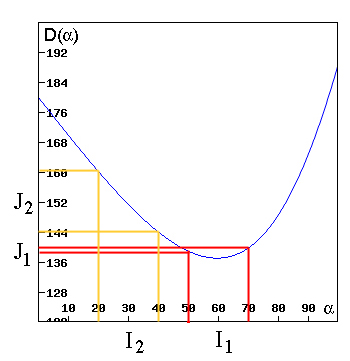We want to show that for any point $\alpha_0 \neq \alpha_m$ the interval $J_2$ coming from any small interval $I_2$ centred on $\alpha_0$ is larger than the interval $J_1$ coming from the interval $I_1$ of the same width as $I_2$, but centred on $\alpha_m$ (see the figure).

Figure 7: The interval J1 is smaller than the interval J2.
Since $\alpha_m$ is the only point with $D_f^\prime(\alpha)=0$ we know that $D_f(\alpha_0)=s \neq 0.$ To match with our figure we'll assume that $s0.$ An analogous argument works when $s>0.$
Now choose a positive number $\epsilon$ with $\epsilon -2s/3$ (you'll see later why we make this choice). From the definition of a derivative we know that there exists $\delta_1>0$ such that for all $\alpha$ with $|\alpha-\alpha_m|\delta_1$ we have
\begin{equation} -\epsilon\frac{D_f(\alpha)-D_f(\alpha_m)}{\alpha-\alpha_m}\epsilon.\end{equation}
Similarly, there exists $\delta_2>0$ such that for all $\alpha$ with $|\alpha-\alpha_0|\delta_2$ we have
\begin{equation} s-\epsilon \frac{D_f(\alpha)-D_f(\alpha_0)}{\alpha-\alpha_0}
D_f(\alpha^\prime_1)-D_f(\alpha_0)$$ and
$$(s+\epsilon)(\alpha_0-\alpha_2^\prime) D_f(\alpha_0)-D_f(\alpha^\prime_2).$$
(The inequalities have changed direction because, since $\alpha^\prime_1\alpha_0\alpha^\prime_2$, we have multiplied by a negative number in each case.)
Putting this together gives
\begin{equation}D_f(\alpha^\prime_1)-D_f(\alpha^\prime_2)=D_f(\alpha^\prime_1)-D_f(\alpha_0)+D_f(\alpha_0)-D_f(\alpha^\prime_2)>(s+\epsilon)(\alpha^\prime_1-\alpha_0) +(s+\epsilon)(\alpha_0-\alpha^\prime_2)=-2\delta(s+\epsilon).\end{equation}
Since $\alpha^\prime$ lies within $\delta_1$ of $\alpha_m$, we know from inequality 1 that
\begin{equation}D_f(\alpha^\prime)-D_f(\alpha_m)\epsilon|\alpha^\prime-\alpha_m|=\epsilon\delta.\end{equation}
And since we have chosen $\epsilon$ so that $\epsilon-2s/3$, putting inequalities 3 and 4 together gives
$$D_f(\alpha^\prime_1)-D_f(\alpha^\prime_2)>-2\delta(s+\epsilon)>\epsilon\delta>D_f(\alpha^\prime)-D_f(\alpha_m).$$
Thus, interval $J_2$ is wider than interval $J_1$. QED.
Back to main article
